The Hico.gdn is just one of the unwanted web-sites that created to fill a web browser constant stream of advertisements, or redirect the Google Chrome, MS Edge, FF and Microsoft Internet Explorer to not expected and intrusive advertising sites. If the Google Chrome, Microsoft Internet Explorer, Microsoft Edge and Firefox started rerouting to the Hico.gdn then you need to know that your personal computer has become a victim of the PUP (potentially unwanted program) from the ‘ad-supported’ software (also known as adware) category. The ad supported software is created in order to provide third-party ads to the user without asking his permission. The ad-supported software takes control of installed web-browsers and redirects them to undesired pages like the Hico.gdn every time you browse the Net.
The adware responsible for Hico.gdn redirect, may inject a large amount of ads directly to the web sites that you visit, creating a sense that the advertisements have been added by the authors of the web page. Moreover, a legal ads may be replaced on the fake ads, that will offer to download and install various unnecessary and harmful software. Even worse, the ‘ad supported’ software can gather confidential data about you (your ip address, what is a web site you are viewing now, what you are looking for on the Net, which links you are clicking), which can later transfer to third parties.
The adware can modify the settings of the Firefox, Microsoft Edge, Google Chrome and Internet Explorer, but often that a malicious software like this can also affect all types of browsers by changing their desktop shortcut files. Thus forcing the user each time run the browser to see the unwanted Hico.gdn web-site.
The instructions below explaining steps to get rid of Hico.gdn pop-up advertisements problem. Feel free to use it for removal of the ad-supported software that may attack Internet Explorer, Google Chrome, Firefox and Microsoft Edge and other popular internet browsers. The instructions will help you get rid of ad supported software and thus clean your browser from all undesired advertisements.
Remove Hico.gdn redirect
In the step-by-step tutorial below, we’ll try to cover the MS Edge, Internet Explorer, Firefox and Google Chrome and provide general advice to get rid of Hico.gdn pop-up ads. You may find some minor differences in your Windows install. No matter, you should be okay if you follow the steps outlined below: delete all suspicious and unknown programs, reset browsers settings, fix web browsers shortcuts, remove malicious scheduled tasks, use free malware removal utilities. Read this manual carefully, bookmark or print it, because you may need to exit your internet browser or restart your system.
To remove Hico.gdn, follow the steps below:
- Delete Hico.gdn pop ups without any utilities
- Remove Hico.gdn associated software by using MS Windows Control Panel
- Remove Hico.gdn ads from Firefox
- Delete Hico.gdn pop up advertisements from Internet Explorer
- Remove Hico.gdn redirect from Google Chrome
- Clean up the web-browsers shortcuts that have been infected by ‘ad supported’ software
- Delete unwanted Scheduled Tasks
- Use free malware removal utilities to completely get rid of Hico.gdn pop ups
- How to block Hico.gdn pop up advertisements
- How to Hico.gdn ads get installed onto PC
- To sum up
Delete Hico.gdn pop ups without any utilities
The step by step guide will help you remove Hico.gdn pop up advertisements. These Hico.gdn removal steps work for the Firefox, Google Chrome, Internet Explorer and Edge, as well as every version of MS Windows operating system.
Remove Hico.gdn associated software by using MS Windows Control Panel
Some potentially unwanted apps, browser hijacking programs and adware can be removed by uninstalling the free software they came with. If this way does not succeed, then looking them up in the list of installed apps in Windows Control Panel. Use the “Uninstall” command in order to remove them.
Windows 8, 8.1, 10
First, click the Windows button
Windows XP, Vista, 7
First, click “Start” and select “Control Panel”.
It will show the Windows Control Panel like below.

Next, click “Uninstall a program” ![]()
It will display a list of all software installed on your system. Scroll through the all list, and delete any dubious and unknown software. To quickly find the latest installed applications, we recommend sort applications by date in the Control panel.
Remove Hico.gdn ads from Firefox
Resetting your Firefox is basic troubleshooting step for any issues with your web-browser application, including the redirect to Hico.gdn site.
First, start the Firefox. Next, press the button in the form of three horizontal stripes (![]() ). It will open the drop-down menu. Next, press the Help button (
). It will open the drop-down menu. Next, press the Help button (![]() ).
).

In the Help menu click the “Troubleshooting Information”. In the upper-right corner of the “Troubleshooting Information” page click on “Refresh Firefox” button like below.

Confirm your action, press the “Refresh Firefox”.
Delete Hico.gdn pop up advertisements from Internet Explorer
By resetting Internet Explorer browser you return your browser settings to its default state. This is first when troubleshooting problems that might have been caused by ‘ad supported’ software that causes multiple intrusive pop-ups.
First, launch the Microsoft Internet Explorer, press ![]() ) button. Next, click “Internet Options” as shown in the following example.
) button. Next, click “Internet Options” as shown in the following example.

In the “Internet Options” screen select the Advanced tab. Next, press Reset button. The IE will show the Reset Internet Explorer settings prompt. Select the “Delete personal settings” check box and click Reset button.

You will now need to restart your PC system for the changes to take effect. It will delete ‘ad supported’ software that responsible for the appearance of Hico.gdn redirect, disable malicious and ad-supported web browser’s extensions and restore the Internet Explorer’s settings like new tab, search provider by default and startpage to default state.
Remove Hico.gdn redirect from Google Chrome
Use the Reset web-browser utility of the Google Chrome to reset all its settings like search engine by default, new tab page and home page to original defaults. This is a very useful tool to use, in the case of web browser redirects to annoying ad web sites such as Hico.gdn.
Open the Chrome menu by clicking on the button in the form of three horizontal dotes (![]() ). It will open the drop-down menu. Select More Tools, then click Extensions.
). It will open the drop-down menu. Select More Tools, then click Extensions.
Carefully browse through the list of installed extensions. If the list has the extension labeled with “Installed by enterprise policy” or “Installed by your administrator”, then complete the following steps: Remove Chrome extensions installed by enterprise policy otherwise, just go to the step below.
Open the Google Chrome main menu again, click to “Settings” option.

Scroll down to the bottom of the page and click on the “Advanced” link. Now scroll down until the Reset settings section is visible, as shown in the figure below and click the “Reset settings to their original defaults” button.

Confirm your action, click the “Reset” button.
Clean up the web-browsers shortcuts that have been infected by ‘ad supported’ software
Now you need to clean up the web browser shortcut files. Check that the shortcut file referring to the right exe-file of the browser, and not on any unknown file.
Open the properties of the browser shortcut file. Right click on the shortcut file of infected browser and select the “Properties” option and it will display the properties of the shortcut. Next, choose the “Shortcut” tab and have a look at the Target field as shown on the image below.
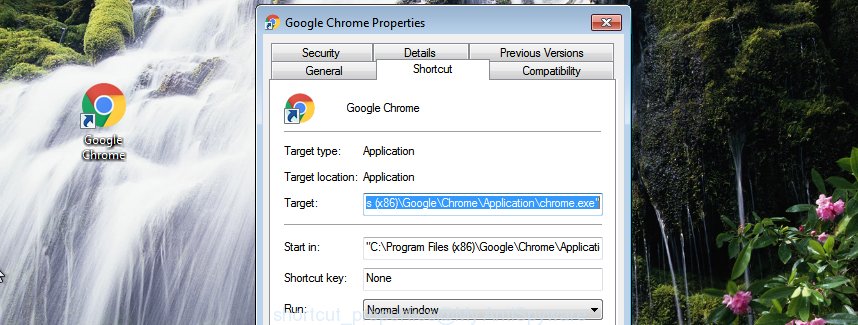
Normally, if the last word in the Target field is chrome.exe, iexplore.exe, firefox.exe. Be sure to pay attention to the extension, should be “exe”! All shortcuts which have been changed by adware that responsible for internet browser redirect to the unwanted Hico.gdn web site, usually point to .bat, .cmd or .url files instead of .exe like below

Another variant, an address has been added at the end of the line. In this case the Target field looks such as …Application\chrome.exe” http://site.address as shown below.

In order to fix the affected shortcut file, you need to insert right path to the Target field or remove an address (if it has been added at the end). You can use the following information to fix your shortcut files which have been altered by adware which redirects your browser to intrusive Hico.gdn page.
| Chrome | C:\Program Files (x86)\Google\Chrome\Application\chrome.exe |
| C:\Program Files\Google\Chrome\Application\chrome.exe | |
| Firefox | C:\Program Files\Mozilla Firefox\firefox.exe |
| Microsoft Internet Explorer | C:\Program Files (x86)\Internet Explorer\iexplore.exe |
| C:\Program Files\Internet Explorer\iexplore.exe | |
| Opera | C:\Program Files (x86)\Opera\launcher.exe |
| C:\Program Files\Opera\launcher.exe |
Once is finished, press OK to save changes. Repeat the step for all browsers which are redirected to the Hico.gdn undesired web-page.
Delete unwanted Scheduled Tasks
Once installed, the adware can add a task in to the Windows Task Scheduler Library. Due to this, every time when you start your personal computer, it will show Hico.gdn undesired site. So, you need to check the Task Scheduler Library and remove all harmful tasks which have been created by adware.
Press Windows and R keys on the keyboard together. This opens a prompt that titled with Run. In the text field, type “taskschd.msc” (without the quotes) and click OK. Task Scheduler window opens. In the left-hand side, press “Task Scheduler Library”, as displayed in the figure below.
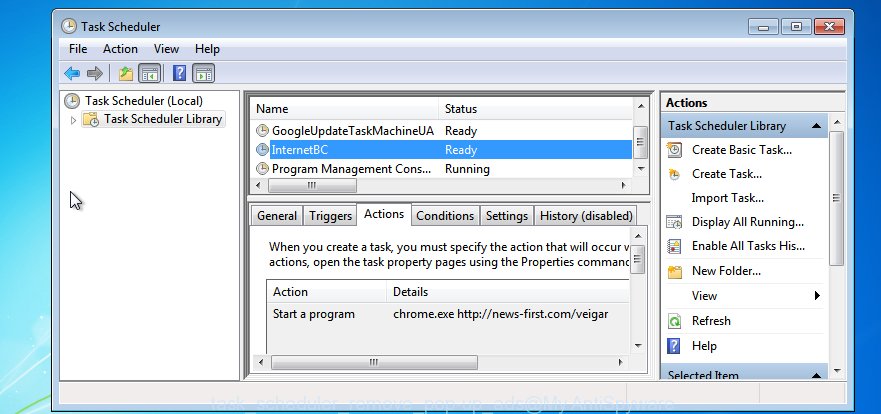
Task scheduler
In the middle part you will see a list of installed tasks. Please select the first task, its properties will be display just below automatically. Next, press the Actions tab. Pay attention to that it launches on your system. Found something like “explorer.exe http://site.address” or “chrome.exe http://site.address”, then remove this malicious task. If you are not sure that executes the task, check it through a search engine. If it is a component of the malicious application, then this task also should be removed.
Having defined the task that you want to remove, then press on it with the right mouse button and choose Delete as shown on the image below.

Delete a task
Repeat this step, if you have found a few tasks that have been created by adware. Once is finished, close the Task Scheduler window.
Use free malware removal utilities to completely get rid of Hico.gdn pop ups
It’s not enough to delete Hico.gdn advertisements from your web-browser by following the manual steps above to solve all problems. Some the ad supported software related files may remain on your PC and they will recover the adware even after you remove it. For that reason we recommend to use free anti-malware tool like Zemana Free, MalwareBytes Anti Malware and HitmanPro. Either of those applications should can search for and remove ad-supported software that causes unwanted Hico.gdn advertisements.
How to remove Hico.gdn pop ups with Zemana Anti-malware
We suggest you to use the Zemana Anti-malware that are completely clean your computer of adware that causes a large count of unwanted Hico.gdn pop up ads. Moreover, the tool will help you to delete potentially unwanted apps, malicious software, toolbars and browser hijacker infections that your machine can be infected too.
Please go to the link below to download Zemana AntiMalware (ZAM). Save it to your Desktop so that you can access the file easily.
164728 downloads
Author: Zemana Ltd
Category: Security tools
Update: July 16, 2019
When the downloading process is finished, start it and follow the prompts. Once installed, the Zemana Anti-Malware will try to update itself and when this process is done, click the “Scan” button to perform a system scan for the adware that responsible for internet browser reroute to the intrusive Hico.gdn web site.

A system scan can take anywhere from 5 to 30 minutes, depending on your PC. While the Zemana Anti-Malware program is checking, you may see how many objects it has identified as threat. Review the results once the tool has finished the system scan. If you think an entry should not be quarantined, then uncheck it. Otherwise, simply press “Next” button.

The Zemana Anti Malware will remove adware that responsible for the appearance of Hico.gdn pop ups and move items to the program’s quarantine.
Remove Hico.gdn pop ups from web browsers with HitmanPro
Hitman Pro is a free utility which can identify ad supported software responsible for redirects to Hico.gdn. It is not always easy to locate all the undesired apps that your machine might have picked up on the Internet. HitmanPro will detect the ad supported software, browser hijackers and other malware you need to erase.
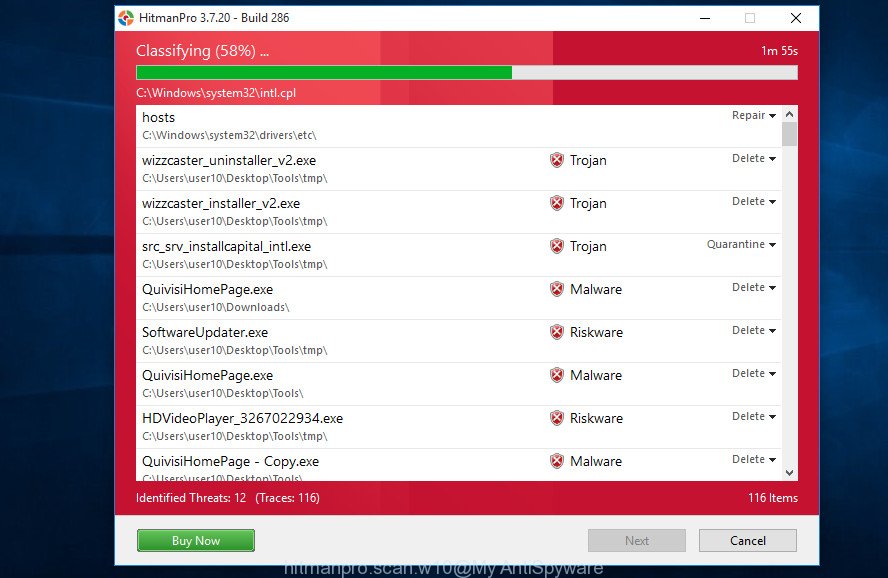
- Installing the HitmanPro is simple. First you will need to download Hitman Pro on your machine by clicking on the following link.
- After the downloading process is done, start the HitmanPro, double-click the HitmanPro.exe file.
- If the “User Account Control” prompts, click Yes to continue.
- In the HitmanPro window, press the “Next” for checking your computer for the ‘ad supported’ software that causes browsers to open annoying Hico.gdn popup ads. When a threat is detected, the number of the security threats will change accordingly.
- Once that process is complete, Hitman Pro will open you the results. Review the scan results and then click “Next”. Now, click the “Activate free license” button to begin the free 30 days trial to remove all malicious software found.
How to remove Hico.gdn with Malwarebytes
We suggest using the Malwarebytes Free that are completely clean your PC system of the adware. The free tool is an advanced malicious software removal program developed by (c) Malwarebytes lab. This program uses the world’s most popular antimalware technology. It’s able to help you remove annoying Hico.gdn redirect from your web-browsers, PUPs, malicious software, browser hijackers, toolbars, ransomware and other security threats from your computer for free.
Click the link below to download MalwareBytes Anti Malware. Save it on your Windows desktop or in any other place.
327001 downloads
Author: Malwarebytes
Category: Security tools
Update: April 15, 2020
When downloading is done, close all apps and windows on your machine. Double-click the install file named mb3-setup. If the “User Account Control” prompt pops up as shown below, click the “Yes” button.
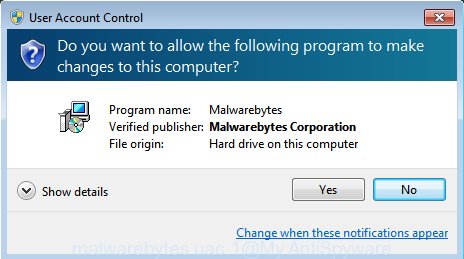
It will open the “Setup wizard” which will help you install MalwareBytes Free on your computer. Follow the prompts and do not make any changes to default settings.
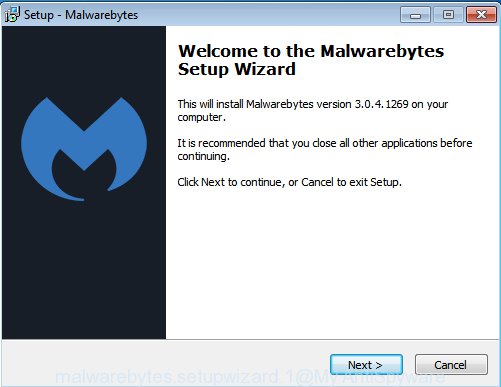
Once installation is done successfully, click Finish button. MalwareBytes AntiMalware will automatically start and you can see its main screen as displayed in the figure below.
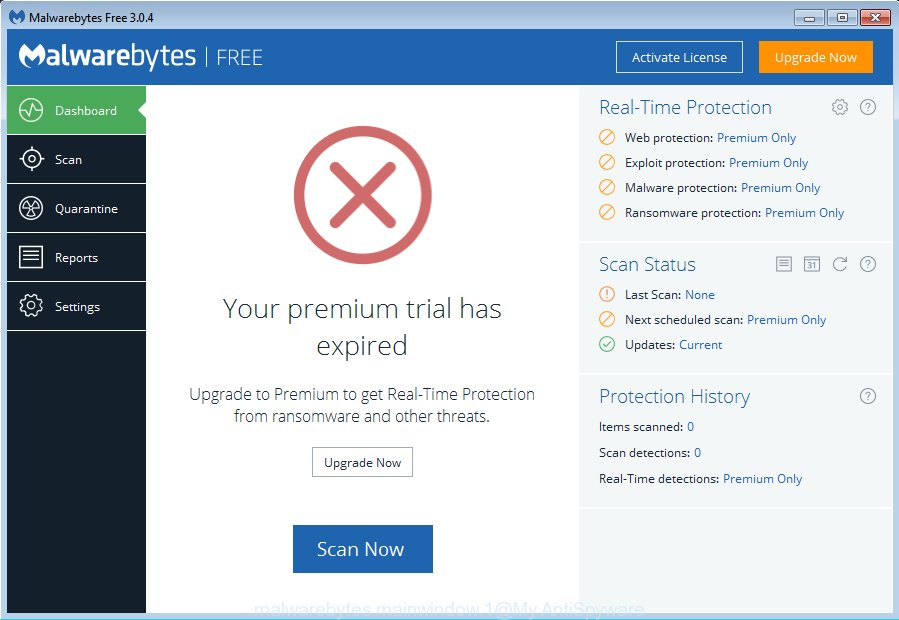
Now click the “Scan Now” button . MalwareBytes AntiMalware (MBAM) tool will start scanning the whole personal computer to find out adware that responsible for internet browser reroute to the intrusive Hico.gdn web page. This procedure can take quite a while, so please be patient.
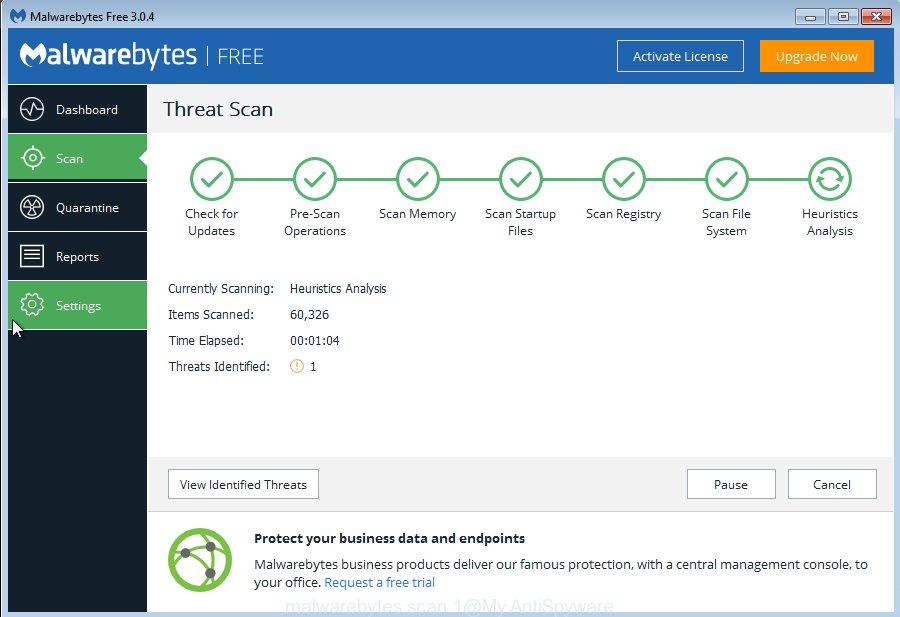
Once MalwareBytes Anti-Malware (MBAM) completes the scan, the results are displayed in the scan report. Review the results once the tool has finished the system scan. If you think an entry should not be quarantined, then uncheck it. Otherwise, simply click “Quarantine Selected” button. The MalwareBytes Anti-Malware will start to delete ad supported software responsible for redirects to Hico.gdn. After the process is done, you may be prompted to reboot the machine.
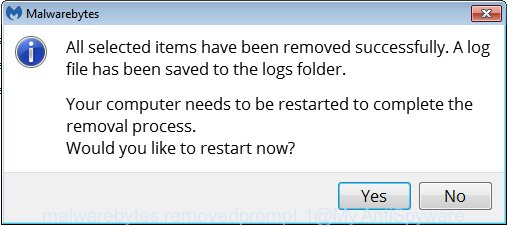
We recommend you look at the following video, which completely explains the process of using the MalwareBytes Free to get rid of adware, browser hijacker and other malware.
How to block Hico.gdn pop up advertisements
We advise to install an ad-blocker application which may block Hico.gdn and other unwanted web sites. The ad blocker utility such as AdGuard is a program that basically removes advertising from the World Wide Web and blocks access to malicious web sites. Moreover, security experts says that using adblocker apps is necessary to stay safe when surfing the Internet.
- Please go to the link below to download AdGuard. Save it on your Microsoft Windows desktop.
Adguard download
26825 downloads
Version: 6.4
Author: © Adguard
Category: Security tools
Update: November 15, 2018
- When the download is complete, start the downloaded file. You will see the “Setup Wizard” program window. Follow the prompts.
- After the installation is finished, click “Skip” to close the installation program and use the default settings, or click “Get Started” to see an quick tutorial that will allow you get to know AdGuard better.
- In most cases, the default settings are enough and you do not need to change anything. Each time, when you start your personal computer, AdGuard will run automatically and stop pop ups, Hico.gdn redirect, as well as other malicious or misleading pages. For an overview of all the features of the program, or to change its settings you can simply double-click on the icon called AdGuard, that is located on your desktop.
How to Hico.gdn ads get installed onto PC
Many of the free software out there install unwanted internet browser toolbars, hijackers and potentially unwanted applications like the adware which reroutes your internet browser to annoying Hico.gdn web-site along with them without your knowledge. One has to be attentive while installing free applications in order to avoid accidentally installing bundled apps. It is important that you pay attention to the EULA (End User License Agreements) and select the Custom, Manual or Advanced installation option as it will typically disclose what additional software will also be installed.
To sum up
Now your personal computer should be clean of the adware that causes web-browsers to display undesired Hico.gdn popup ads. We suggest that you keep AdGuard (to help you stop unwanted popups and undesired malicious web-pages) and Zemana (to periodically scan your system for new ‘ad supported’ softwares and other malware). Probably you are running an older version of Java or Adobe Flash Player. This can be a security risk, so download and install the latest version right now.
If you are still having problems while trying to get rid of Hico.gdn pop ups from the Edge, IE, Firefox and Google Chrome, then ask for help in our Spyware/Malware removal forum.




















